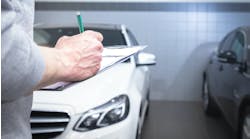We recently repaired a Tesla at one of my shops, and that cost us a surprising amount of man hours.
Here’s why: we wanted to print the repair procedures for that vehicle, which consisted of 128 pages. We wanted to print them in color, because that’s color coded, so we had to print them at a local copy shop. It cost us $80 to print all that.
These days, not only do we have an employee research OEM repair procedures, but we also have someone go print them, and someone organize all that and put it in a binder. So, for that aforementioned Tesla, we spent multiple hours on the task of pulling repair procedures.
If I hadn’t already been convinced of it before, I certainly was after that experience: my body shops—and any decent-sized body shops out there, for that matter—need to consider adding a new position on their shop floor.
You could call this new role a “repair planning technician,” a “repair research technician,” or a “repair research coordinator.” However you want to term it, that position is needed at most shops these days. These repair research technicians would have tasks like bringing vehicles onto the shop floor, verifying that everything has been written with regard to disassembly, and then pull repair procedures.
I think you’ll see shops all over add positions like this in the not-too-distant future.
Over the last few years, you’ve seen a lot of shops add positions like this, in essence, without really thinking about it. Ten years ago, we had insurance companies doing adjusting, and now you don’t. Now we’re doing it in body shops and we’re sending it via the Internet to them. So, without even noticing, we started adding estimators; now we’re at one estimator per each technician.
I think, throughout much of the industry, we’ve reached a point where we’re adding a lot of stress to our current staffs by adding responsibilities like pulling repair procedures when employees already have their regular jobs to do.
Along those lines, at my shops, we went from one back-end estimator to two back-end estimators per team. It started as more of a training ground. Our goal is to build these guys and gals up, and then they could eventually have their own team. Or, they may stay as a true technical estimator team, so that one can pull repair procedures, one can do the scan, and the other can hop in and do calibrations.
So, how do we budget for new staff positions like this? Well, we have to figure out ways to maintain a very high labor gross profit. We used to say in the industry that shops would make 50 percent gross profit on labor, then it went to 60 percent, and now we’re looking at being in the 70-75 percent range for gross profit on labor, so that we can apply those dollars to admin expenses and training costs. Your budget today has to be focused on maintaining a very solid gross profit.
Also, it’s important to let your technicians know how you’re formulating your budget. Because they’ll occasionally get offers from shops that might get a higher hourly rate because that shop’s maintaining a lower gross profit. But, at the end of the day, how is that shop going to be able to afford to fix cars properly if they don’t have a high-labor gross profit?
My staff knows what I spend on training, and they know that I budget for top-of-the-line tools and equipment like state-of-the-art welders. You’ve got to let your employees know what you’re doing in terms of your budget, why you’re doing it, and how you’re doing it. I think that’s how you develop trust throughout your entire staff.




